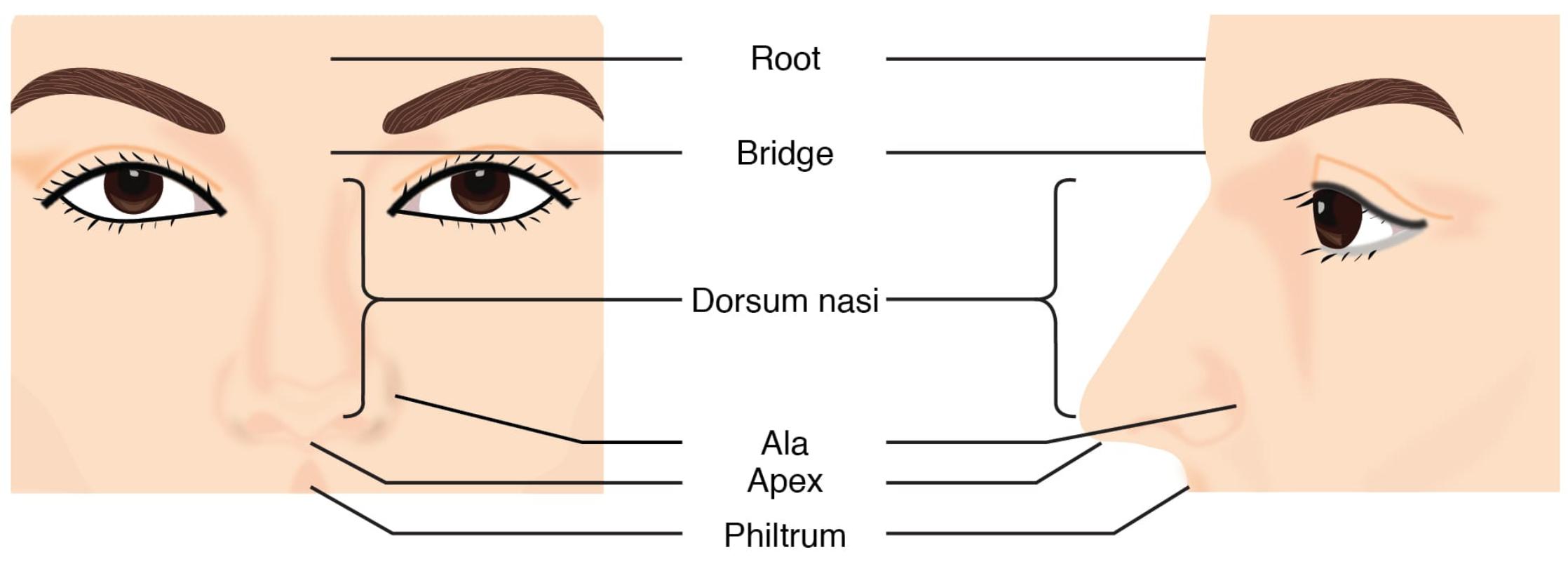The external nose is a prominent facial feature that plays a vital role in respiration and olfaction, as detailed in the provided diagram. This article delves into the anatomical components illustrated, offering a thorough understanding of its structure and function. By examining these elements, one can appreciate the nose’s significance in both aesthetic and physiological contexts.

Nasal bone: These paired bones form the upper bridge of the nose, providing structural support and protection. They articulate with the frontal bone and maxilla, contributing to the nose’s rigidity.
Nasal cartilage: This flexible tissue, including the septal and alar cartilages, shapes the lower and middle portions of the nose. It allows for slight movement and resilience while maintaining the nasal airway.
Nasal septum: This vertical partition, composed of cartilage and bone, divides the nasal cavity into two nostrils. It ensures proper airflow and supports the overall nasal framework.
Ala nasi: These wing-like structures form the outer edges of the nostrils, made of cartilage and soft tissue. They help regulate airflow and can dilate or constrict during breathing.
Nostril (Naris): This external opening of the nasal cavity allows air to enter and exit the respiratory system. Each nostril is lined with hair and mucus to filter incoming air.
Philtrum: This midline groove runs from the nasal septum to the upper lip, marking the fusion line of facial tissues during embryonic development. It adds to the nose’s aesthetic contour.
Anatomical Structure of the External Nose
The external nose’s anatomy is a blend of bone and cartilage, designed for both function and form. Each part contributes to its overall effectiveness.
- The nasal bone provides a sturdy foundation for the upper nose.
- The nasal cartilage offers flexibility, adapting to facial expressions.
- The nasal septum ensures symmetrical airflow through both nostrils.
- The ala nasi supports the nostrils’ shape and airflow regulation.
- The nostril (naris) serves as the entry point for respiratory and olfactory functions.
Physiological Functions of the External Nose
The external nose performs essential roles in respiration and sensory perception. Its structure supports these critical processes.
- The nasal bone and nasal cartilage protect the nasal passages from injury.
- The nasal septum directs airflow, preventing obstruction.
- The ala nasi adjusts nostril size to optimize breathing efficiency.
- The nostril (naris) filters dust and pathogens with nasal hair.
- The philtrum has no direct physiological role but aids in facial recognition.
Clinical Relevance and Health Considerations
While the diagram focuses on anatomy, the external nose’s health is vital for overall well-being. Awareness of potential issues can guide care.
- Fractures of the nasal bone are common and may require surgical realignment.
- Deviated nasal septum can cause breathing difficulties, treatable with septoplasty.
- Infections or injuries to the ala nasi may affect airflow and require antibiotics.
- Narrow nostril (naris) openings can lead to snoring or sleep apnea.
- The philtrum’s appearance can be altered by cleft lip, correctable with surgery.
The external nose, as depicted, showcases the harmonious integration of the nasal bone, nasal cartilage, nasal septum, ala nasi, nostril (naris), and philtrum in supporting respiration and olfaction. This anatomical guide provides a foundation for exploring its physiological roles and clinical significance. By studying these structures, one can better understand their importance in maintaining health and addressing related conditions effectively.

